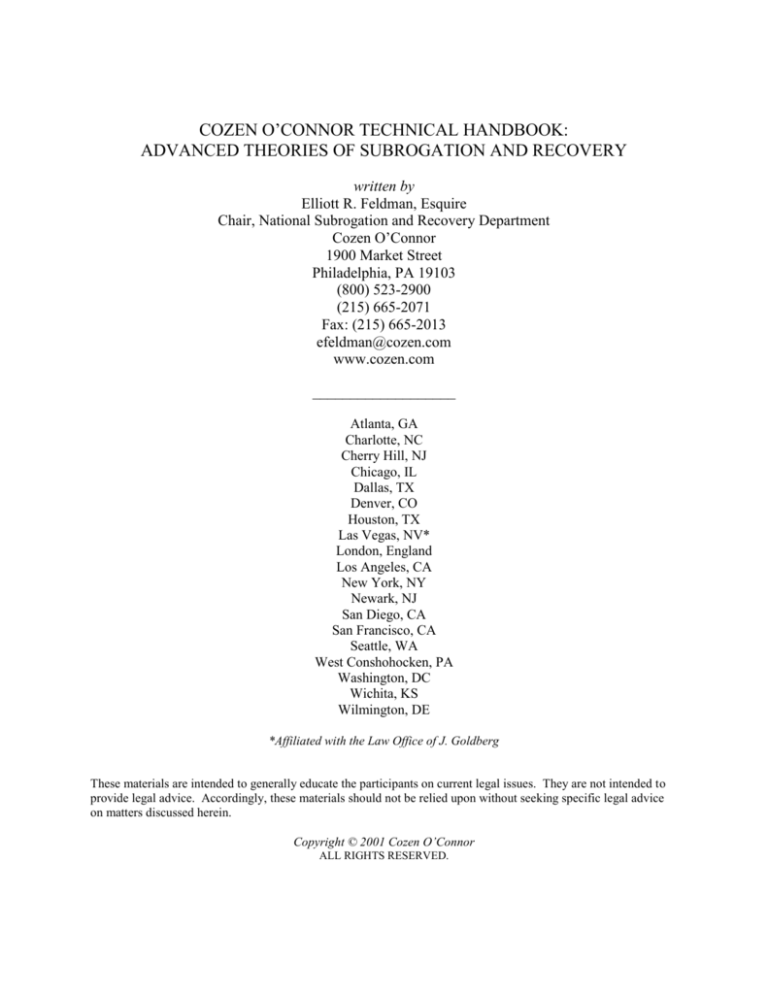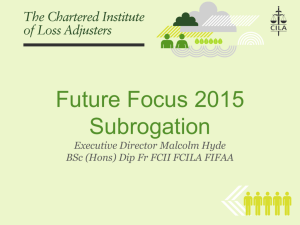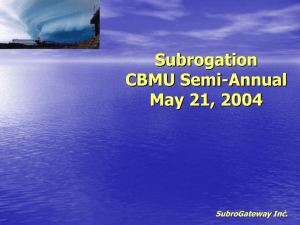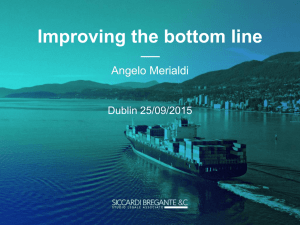
COZEN O’CONNOR TECHNICAL HANDBOOK:
ADVANCED THEORIES OF SUBROGATION AND RECOVERY
written by
Elliott R. Feldman, Esquire
Chair, National Subrogation and Recovery Department
Cozen O’Connor
1900 Market Street
Philadelphia, PA 19103
(800) 523-2900
(215) 665-2071
Fax: (215) 665-2013
efeldman@cozen.com
www.cozen.com
___________________
Atlanta, GA
Charlotte, NC
Cherry Hill, NJ
Chicago, IL
Dallas, TX
Denver, CO
Houston, TX
Las Vegas, NV*
London, England
Los Angeles, CA
New York, NY
Newark, NJ
San Diego, CA
San Francisco, CA
Seattle, WA
West Conshohocken, PA
Washington, DC
Wichita, KS
Wilmington, DE
*Affiliated with the Law Office of J. Goldberg
These materials are intended to generally educate the participants on current legal issues. They are not intended to
provide legal advice. Accordingly, these materials should not be relied upon without seeking specific legal advice
on matters discussed herein.
Copyright © 2001 Cozen O’Connor
ALL RIGHTS RESERVED.
Cozen O’Connor Technical Handbook:
ADVANCED THEORIES OF SUBROGATION AND RECOVERY
by Elliott R. Feldman, Esquire
I.
INTRODUCTION
It is fundamental that three elements are necessary to support combustion: heat; oxygen;
and fuel. Indeed, the fire triangle’s dependence on all three of its sides is recognized and utilized
in firefighting efforts, which typically target one or more of these elements in an effort to control,
contain and extinguish fires. In recent years, it has been recognized that open flaming
combustion also requires an uninhibited chemical chain reaction, inducing some commentators
to add a fourth side resulting in a fire tetrahedron or rectangle.
This paper will discuss recovery opportunities in challenging loss scenarios where: there
is no known or provable cause of the fire; or, the fire is the fault and responsibility of your
insured; or, the fire was caused by uninsured or judgment-proof third parties.
II.
FAILURE TO PREVENT: FOCUS ON IGNITION SOURCE
There are a number of recovery opportunities that are present when a fire is caused by a
person or entity who cannot be pursued for subrogation purposes, but there is another responsible
third party who fails to prevent the fire. For example, your insured, either on his or her own in a
personal lines context, or through in-house maintenance and technical employees in a
commercial risk, may be responsible for having installed deficient wiring which brings about an
electrical failure. It is rare to encounter residences or commercial or industrial occupancies
which do not utilize electrical overcurrent protective devices. Therefore, for every such
electrical fire caused by negligent work by your insured, one must inquire whether there has been
substandard performance of circuit breakers, fuses, relays or other protective equipment which
transforms an electrical failure into an electrical fire. Issues that must be addressed will include
manufacturing or design defects, improper settings or calibrations, and deterioration due to
infrequent operation.
Other loss scenarios in which the fire cause itself may not give rise to a subrogation
claim, but where failure to prevent the fire does, would include equipment, such as saunas or
other heaters which “invite” a user to place clothing, towels or other combustibles on or near the
heater, and which do not contain guards to distance such combustibles to prevent them from
igniting. Guards frequently are mandated by industry standards or applicable building and fire
codes, and have the additional beneficial effect of limiting fuel so as to allow fires to selfextinguish.
There are numerous other loss scenarios in which the failure to prevent a fire may give
rise to third-party responsibility, including:
2
III.
Late reporting of the fire by a security guard, an employee or occupant of the
premises origin, or a resident of the household where the fire originated;
Delayed response by the responsible fire department;
Delayed response by an electrical or gas utility company, which is responsible for
terminating gas and/or electric service before firefighting activities can be
commenced;
Deficient fire safety training of employees in an occupancy where the fire originates;
Inadequate water supply by a municipal or private water authority;
Defective valves/connections for firefighting apparatus to connect to a sprinkler
system;
Defectively designed or negligently installed fire detection or suppression systems;
Defectively designed or negligently installed fire alarm equipment;
Substandard monitoring of central station fire alarm equipment;
Code violative electrical grounding systems, including inadequate voltage surge
protection and/or deficient lightning arresting equipment;
Failure to install fire detection/suppression equipment in hazardous environments;
Negligent inspection by governmental agencies or private inspection entities.
OXYGEN: ONE OF THE “FORGOTTEN” ELEMENTS OF THE FIRE
TRIANGLE
The next section of this paper will focus upon those loss scenarios where there is no third
party liability either for causing or for failing to prevent the fire. Under these circumstances, it
behooves the subrogation professional to evaluate potential liability for creating conditions
which give rise to sustained combustion by causing and/or allowing the presence of one or both
of the other elements of the fire triangle. Initially, one must ask what the effect is of providing
access to oxygen: in some losses, continued supply of oxygen will allow a fire to combust and to
sustain combustion, thereby causing fire spread and development. This is illustrated by fire
doors which fail to close, or inadequate firestopping or compartmentalization.
There frequently are building and fire code requirements with volumetric limitations for
storage of materials in an unsprinklered warehousing occupancy. There also may be liability for
code violative openings or chases for pipes, conduits and mechanical systems.
Defectively designed or negligently installed Ansul systems or other chemically based
fire suppression systems designed to smother a fire also may give rise to third-party liability.
3
All of the foregoing scenarios represent situations in which third-party liability may be
imposed on the basis of providing oxygen and thereby causing and/or sustaining combustion. By
contrast, third-party liability may be present where, for instance, solvents are used and expressly
require “adequate ventilation” in order to prevent gaseous by-products from creating an
explosive mixture. Depriving access to oxygen can cause a flammable or explosive environment
to be created within the lower explosive limit and the upper explosive limit of flammable and
combustible gases. Failure to comply with ventilation requirements implicates negligent use by
a contractor and/or inadequate warnings and instructions by the manufacturer.
IV.
FUELING THE FIRE
The third element of the fire triangle, fuel, must be evaluated independently as a grounds
for imposing third-party responsibility for the unreasonably dangerous spread or growth of a fire.
This is illustrated, for example, by polyurethane foam cushions which are virtually ubiquitous in
current residential and commercial occupancies. Moreover, as is discussed below, the
flammability hazards represented by polyurethane foam - which some commentators have
characterized as being paramount to solid gasoline - are easily mitigated by the use of chemically
injected flame retardants.
Other highly flammable fuels which, in and of themselves, may represent unreasonably
dangerous and defective products, include:
Fabrics, which may be displayed in bulk in mercantile occupancies regulated by code;
Synthetic materials stored in a warehousing facility; and
Plastic appliances with a heating element such as a coffeemaker or hot plate.
Moreover, certain products - such as pre-packaged breakfast and pastry products - are
intended for use with an extremely hot and dangerous heat source, consisting of the heating
element in a typical toaster or toaster oven. When the ingredients in the food include - as they
almost always do - copious amounts of sugar and flour, there is a readily available supply of fuel
which can support surprisingly intense fires. Whenever one product - such as a light bulb - is
intended for use in another product - a fixture - made by a separate manufacturer, issues are
implicated regarding compatibility, suitability of warnings and instructions, and safer alternative
designs.
The flammability hazards of products typically are measured by their flame spread rates.
For instance, a material that burns faster than 1/10th of an inch per second frequently is regulated
as a “flammable solid”, meaning that it must be stored, above certain reasonable limits (e.g., 100
cubic feet) in a sprinklered occupancy.
All such products should be evaluated to determine whether flame retardants reasonably
and feasibly can be added without impairing the utility of such products. Design issues must be
explored concerning whether internal fire barriers can be installed to limit fire spread.
4
Typical materials which are regulated by industry standards concerning required or
recommended use of flame retardants include:
Fabrics (cotton, acrylics, wool and synthetic fibers);
Building materials (wall coverings, floor coverings, insulation, plywood);
Home and business furnishings (carpeting, carpet padding, beddings, mattresses and
textiles);
Vehicles (passenger cars, trucks and trailers).
The absence of approved thermal barriers also may give rise to liability in applications
such as exterior wall cladding, interior insulation, and wall or floor coverings which have
hazardous flame spread characteristics.
The creation of a fire hazard, sufficient to impose liability, may be found where there is
unsafe or excessive accumulation of trash, waste materials and debris in non-approved
containers. This frequently creates an “attractive nuisance” which invites trespassers who, in
turn, negligently, recklessly or intentionally are responsible for initiating the fire. Nonetheless,
the owner or occupant who creates the hazardous conditions in which the fire occurs frequently
has independent liability and generally represents a more economically viable target of a
subrogation claim.
One also must evaluate code violative warehousing or storage procedures, such as storing
materials at an excessive height, above sprinkler heads where activation of the sprinkler system
will fall below the seat of the fire, or storing materials with inadequate aisle widths, thus creating
a bridge for fire to travel from one unit of fuel to another.
Flammable liquids generally are regulated with respect to the quantity and method of
storage, i.e., in approved containers within a secure flammable liquid environment. These
materials frequently implicate the need for specialized fire detection and suppression equipment.
Where there is utilization of gas or liquid propane supply lines or containers, or there is
equipment such as furnaces, ovens, dryers and heaters using gas as fuel, codes generally require
automatic shutoff valves which are triggered by activation of the automatic fire detection and
suppression system. All of this equipment must be evaluated with respect to its design, settings
and operation.
V.
CONCLUSION
There are significant recovery opportunities in fire loss scenarios where the cause of the
fire does not give rise to third-party liability. The most successful subrogation programs are
designed to ensure thorough evaluation of all reasonable theories of liability to be applied to all
“actors” whose activities have played a significant role in failing to prevent the fire, and/or in
sustaining combustion by virtue of causing one or more of the necessary elements of the fire
triangle to be present. Cozen O’Connor is available to consult with you on all claims of this
nature to ensure that your company does not sustain a loss in revenue by failing to pursue, where
5
appropriate, recovery claims against responsible third parties whose culpable conduct causes all
or part of the damage to your insured.
6












